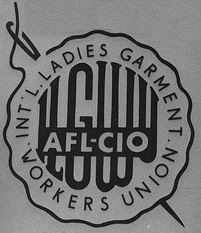International Ladies' Garment Workers' Union
 |
|
| Full name | International Ladies' Garment Workers' Union |
|---|---|
| Founded | 1900 |
| Date dissolved | 1995 |
| Merged into | UNITE |
| Members | 450,000 (1969) |
| Affiliation | AFL, AFL-CIO |
| Country | United States of America |
The International Ladies' Garment Workers' Union (ILGWU) was once one of the largest labor unions in the United States, one of the first U.S. unions to have a primarily female membership, and a key player in the labor history of the 1920s and 1930s. The union, generally referred to as the "ILGWU" or the "ILG," merged with the Amalgamated Clothing and Textile Workers Union in 1995 to form the Union of Needletrades, Industrial and Textile Employees (UNITE). UNITE merged with the Hotel Employees and Restaurant Employees Union (HERE) in 2004 to create a new union known as UNITE HERE. The two unions that formed UNITE in 1995 represented 250,000 workers between them, down from the ILGWU's peak membership of 450,000 in 1969.
The ILGWU was founded on June 3, 1900 in New York City by seven local unions, with a few thousand members between them. The union grew rapidly in the next few years but began to stagnate as the conservative leadership favored the interests of skilled workers, such as cutters. This did not sit well with the majority of immigrant workers, particularly Jewish workers with a background in Bundist activities in Tsarist Russia, or with Polish and Italian workers, many of whom had strong socialist and anarchist leanings.
The ILGWU had a sudden upsurge in membership that came as the result of two successful mass strikes in New York City.
The first, in 1909, was known as “the Uprising of 20,000” and lasted for fourteen weeks. It was largely spontaneous, sparked by a short walkout of workers of the Triangle Shirtwaist Factory, involving only about 20% of the workforce. That, however, only prompted the rest of the workers to seek help from the union. The firm locked out its employees when it learned what was happening.
The news of the strike spread quickly to all the New York garment workers. At a series of mass meetings, after the leading figures of the American labor movement spoke in general terms about the need for solidarity and preparedness, Clara Lemlich rose to speak about the conditions she and other women worked under and demanded an end to talk and the calling of a strike of the entire industry. The crowd responded enthusiastically and, after taking a traditional Yiddish oath, "If I turn traitor to the cause I now pledge, may this hand wither from the arm I now raise," voted for a general strike. Approximately 20,000 out of the 32,000 workers in the shirtwaist trade walked out in the next two days.
...
Wikipedia
